Combining Cirrus and Aerosol Corrections for Improved Reflectance Retrievals over Turbid Waters from Visible Infrared Imaging Radiometer Suite Data
Abstract
1. Introduction
2. Data and Methods
2.1. The VIIRS Instrument
2.2. The VIIRS Cirrus Reflectance Algorithm
2.3. Atmospheric Correction Algorithms for Coastal Waters
2.3.1. The Development of a Hyperspectral Atmospheric Correction Algorithm
2.3.2. The Development of Multi-Band Atmospheric Correction Algorithms
2.3.3. Combining Cirrus and Aerosol Corrections for Improved Retrieval of Turbid Water Reflectances
2.4. NASA Remote Sensing Reflectance Algorithms
3. Results
3.1. A VIIRS Scene off the Eastern Coastal Area of Argentina, 17 December 2018
3.2. A VIIRS Scene over Turbid Arctic Lake, 19 June 2021
3.3. A VIIRS Scene Covering Bahamas Banks Area, 11 January 2015
3.4. A VIIRS Scene over the East China Sea, 6 April 2012
4. Discussion
5. Summary and Conclusions
Author Contributions
Funding
Institutional Review Board Statement
Data Availability Statement
Acknowledgments
Conflicts of Interest
References
- Groom, S.; Sathyendranath, S.; Ban, Y.; Bernard, S.; Brewin, R.; Brotas, V.; Brockmann, C.; Chauhan, P.; Choi, J.K.; Chuprin, A.; et al. Satellite ocean colour: Current status and future perspective. Front. Mar. Sci. 2019, 6, 485. [Google Scholar] [CrossRef] [PubMed]
- McClain, C.R.; Franz, B.A.; Werdell, P.J. Genesis and evolution of NASA’s satellite ocean color program. Front. Remote Sens. 2022, 3, 938006. [Google Scholar] [CrossRef]
- Bisson, K.M.; Boss, E.; Werdell, P.J.; Ibrahim, A.; Frouin, R.; Behrenfeld, M.J. Seasonal bias in global ocean color observations. Appl. Opt. 2021, 60, 6978–6988. [Google Scholar] [CrossRef] [PubMed]
- Meister, G.; Franz, B.A.; McClain, C.R. Influence of thin cirrus clouds on ocean color products. Proc. SPIE 2009, 7459, 745903-1–745903-12. [Google Scholar]
- Bailey, S.W.; Franz, B.A.; Werdell, P.J. Estimation of near-infrared water leaving reflectance for satellite ocean color data processing. Opt. Express 2020, 18, 7521–7527. [Google Scholar] [CrossRef]
- Available online: https://www.star.nesdis.noaa.gov/socd/mecb/color/ocview/ocview.html (accessed on 1 November 2024).
- Wang, M.; Son, S.; Harding, L.W. Retrieval of diffuse attenuation coefficient in the Chesapeake Bay and turbid ocean regions for satellite ocean color applications. J. Geophys. Res. 2009, 114, C10011. [Google Scholar] [CrossRef]
- Ibrahim, A.; Franz, B.; Bailey, S.; Werdell, J.; Ahmad, Z.; Mobley, C. Remote Sensing Reflectance. Available online: https://www.earthdata.nasa.gov/apt/documents/rrs/v1.1 (accessed on 3 December 2024).
- Franz, B.A.; Werdell, P.J.; Meister, G.; Kwiatkowska, E.J.; Bailey, S.W.; Ahmad, Z.; McClain, C.R. MODIS land bands for ocean remote sensing applications. In Proceedings of the Ocean Optics XVIII, Montreal, QC, Canada, 9–13 October 2006. [Google Scholar]
- Gao, B.C.; Li, R.R. Removal of thin cirrus scattering effects in Landsat 8 OLI images using the cirrus detecting channels. Remote Sens. 2017, 9, 834. [Google Scholar] [CrossRef]
- Gao, B.C.; Li, R.R. The VIIRS cirrus reflectance algorithm. Sensors 2023, 23, 2234. [Google Scholar] [CrossRef]
- Gao, B.C.; Li, R.R. A multi-band atmospheric correction algorithm for deriving water leaving reflectances over turbid waters from VIIRS data. Remote Sens. 2023, 15, 425. [Google Scholar] [CrossRef]
- Moyer, A.; McIntire, J.; Young, J.; McCarthy, J.K.; Waluschka, E.; Xiong, X.; De Luccia, F.J. JPSS-1 VIIRS prelaunch polarization testing and performance. IEEE Trans. Geosc. Remote Sens. 2017, 55, 2463–2476. [Google Scholar] [CrossRef]
- Gao, B.-C.; Montes, M.J.; Ahmad, Z.; Davis, C.O. Atmospheric correction algorithm for hyperspectral remote sensing of ocean color from space. Appl. Opt. 2000, 39, 887–896. [Google Scholar] [CrossRef] [PubMed]
- Wilson, T.; Davis, C. Naval EarthMap Observer (NEMO) Satellite. 1999. Available online: https://www.spiedigitallibrary.org/conference-proceedings-of-spie/3753/0000/Naval-EarthMap-Observer-NEMO-satellite/10.1117/12.366268.pdf (accessed on 19 November 2024).
- Vane, G.; Green, R.O.; Chrien, T.G.; Enmark, H.; Hansen, E.G.; Porter, W.M. The Airborne Visible/Infrared Imaging Spectrometer. Remote Sens. Environ. 1993, 44, 127–143. [Google Scholar] [CrossRef]
- Gordon, H.; Wang, M. Retrieval of water-leaving radiance and aerosol optical thickness over the oceans with SeaWiFS: A preliminary algorithm. Appl. Opt. 1994, 33, 443–452. [Google Scholar] [CrossRef]
- Fraser, R.S.; Mattoo, S.; Yeh, E.-N.; McClain, C.R. Algorithm for atmospheric and glint corrections of satellite measurements of ocean pigment. J. Geophys. Res. 1997, 102, 17107–17118. [Google Scholar] [CrossRef]
- Fraser, R.; Ferrare, R.; Kaufman, Y.J.; Mattoo, S. Algorithm for atmospheric corrections of aircraft and satellite imagery. NASA Tech. Memo. 1989, 13, 100751. [Google Scholar] [CrossRef]
- Tanre, D.; Deroo, C.; Duhaut, P.; Herman, M.; Morcrette, J.J.; Perbos, J.; Deschamps, P.Y. Description of a computer code to simulate the satellite signal in the solar spectrum: The 5S code. Int. J. Remote Sens. 1990, 11, 659–668. [Google Scholar] [CrossRef]
- Ahmad, Z.; Fraser, R.S. An iterative radiative transfer code for ocean-atmosphere systems. J. Atmos. Sci. 1982, 39, 656–665. [Google Scholar] [CrossRef]
- Gao, B.-C.; Montes, M.J.; Li, R.-R.; Dierssen, H.M.; Davis, C.O. An atmospheric correction algorithm for remote sensing of bright coastal waters using MODIS land and ocean channels in the solar spectral region. IEEE Trans. Geosc. Remote Sens. 2007, 45, 1835–1843. [Google Scholar] [CrossRef]
- Available online: https://modis.gsfc.nasa.gov/sci_team/meetings/201505/presentations/atmosphere/gao.pdf (accessed on 19 November 2024).
- Zhai, P.W.; Hu, Y.X. An improved pseudo spherical shell algorithm for vector radiative transfer. J. Quant. Spectrosc. Radiat. Transf. 2022, 282, 108132. [Google Scholar] [CrossRef]
- Zhai, P.W.; Gao, M.; Franz, B.A.; Werdell, P.J.; Ibrahim, A.; Hu, Y.; Chowdhary, J. A radiative transfer simulator for PACE: Theory and applications. Front. Remote Sens. 2022, 3, 840188. [Google Scholar] [CrossRef]
- Nazaryan, H.; McCormick, M.P.; Menzel, W.P. Global characterization of cirrus clouds using CALIPSO data. J. Geophys. Res. 2008, 113, D16211. [Google Scholar] [CrossRef]
- Gao, B.C.; Kaufman, Y.J.; Tanre, D.; Li, R.R. Distinguishing tropospheric aerosols from thin cirrus clouds for improved aerosol retrievals using the ratio of 1.38-mm and 1.24-mm channels. Geophys. Res. Lett. 2002, 29, 1890. [Google Scholar] [CrossRef]
- Moran, M.S.; Jackson, R.D.; Slater, P.N.; Teillet, P.M. Evaluation of simplified procedures for retrieval of land surface reflectance factors from satellite sensor output. Remote Sens. Environ. 1992, 41, 169–184. [Google Scholar] [CrossRef]
- Fraser, R.S.; Kaufman, Y.J. The relative importance of aerosol scattering and absorption in remote sensing. IEEE Transc. Geosci. Remote Sens. 1985, GE-23, 625–633. [Google Scholar] [CrossRef]
- Mobley, C.D.; Werdell, J.; Franz, B.; Ahmad, Z.; Bailey, S. Atmospheric Correction for Satellite Ocean Color Radiometry; NASA T/M-2016-217551; NASA Goddard Space Flight Center: Greenbelt, MD, USA, 2016; p. 73.
- Hedley, J.; Harborne, A.; Mumby, O. Simple and robust removal of sun glint for mapping shallow-water benthos. Int. J. Remote Sens. 2005, 26, 2107–2112. [Google Scholar] [CrossRef]
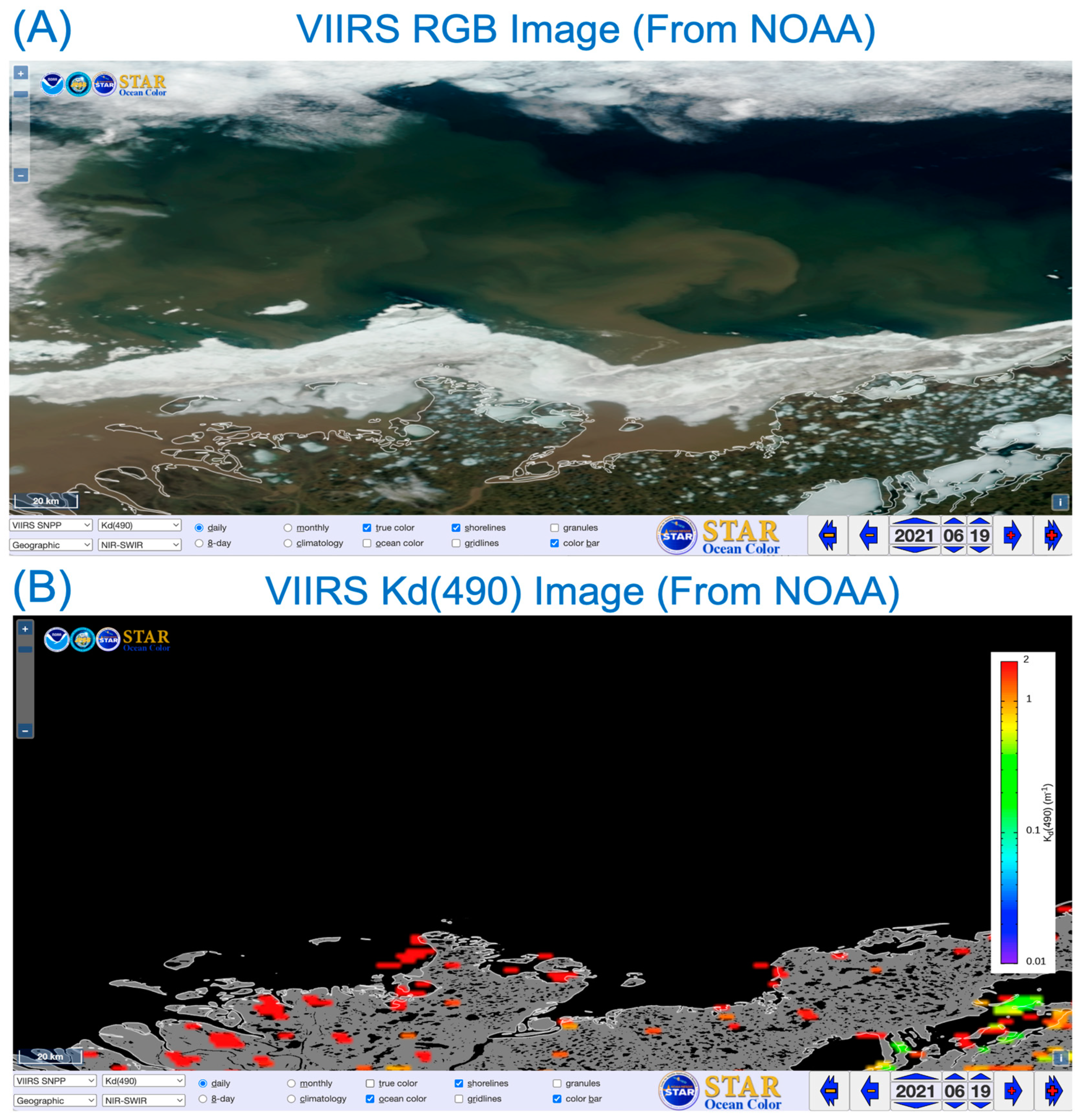
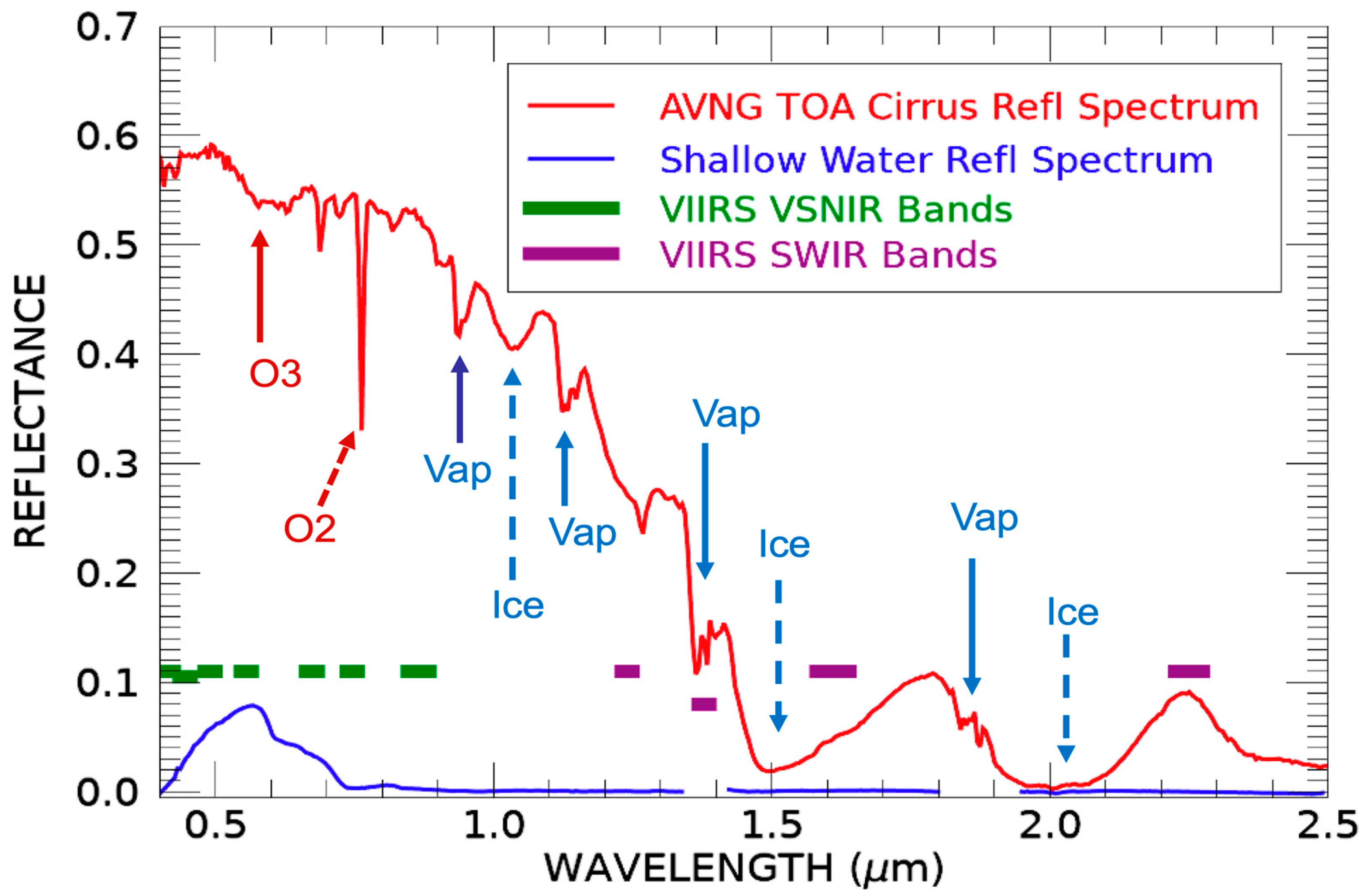

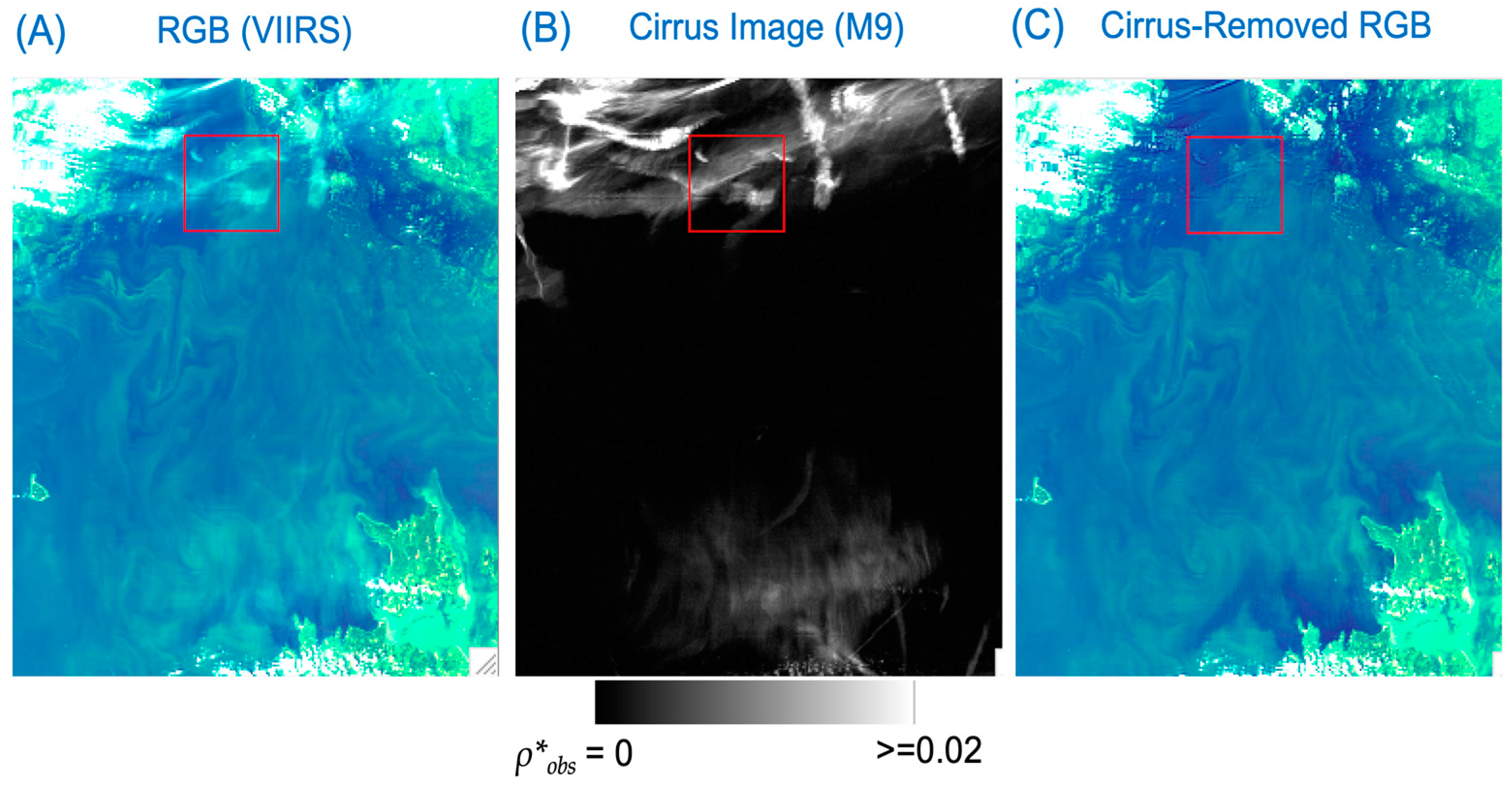
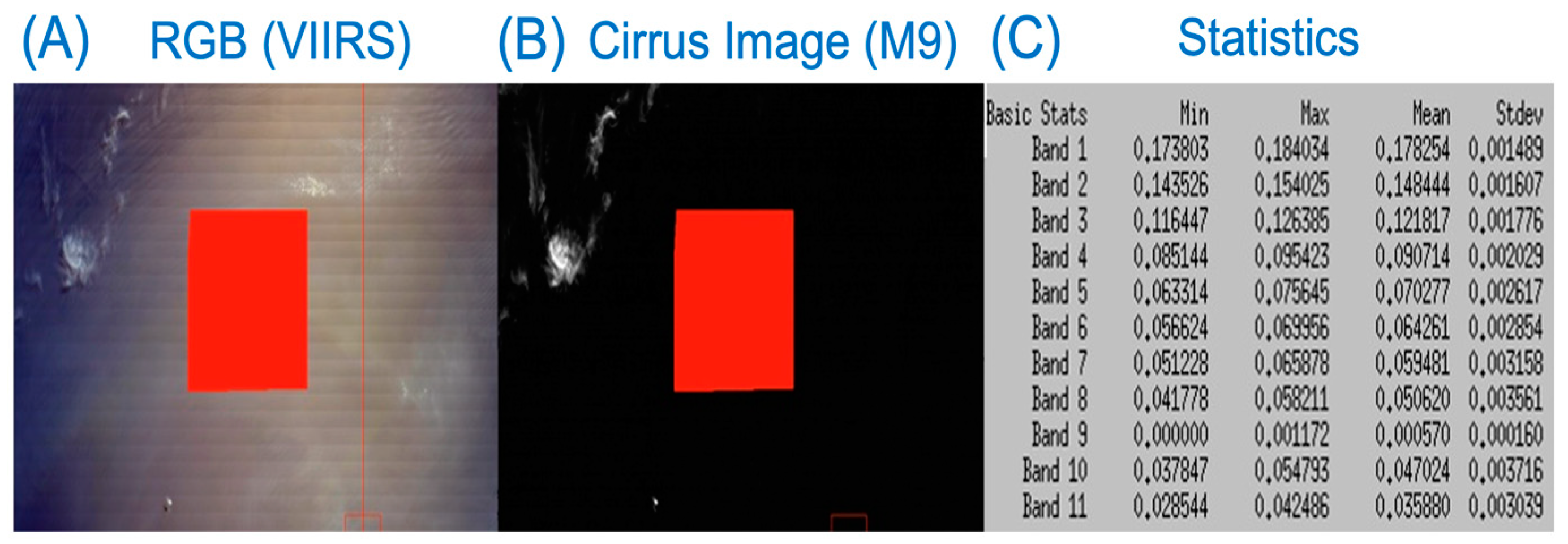
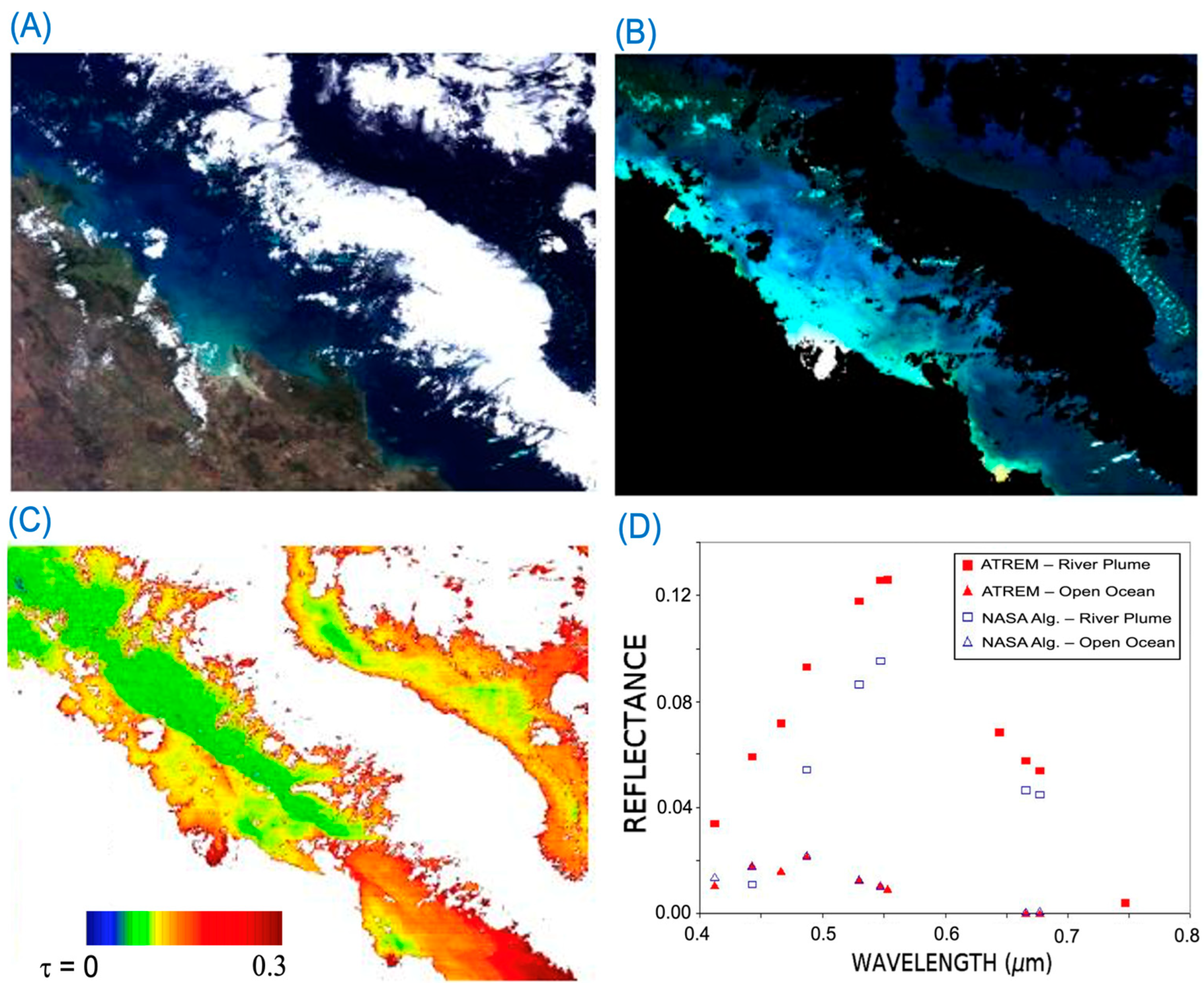
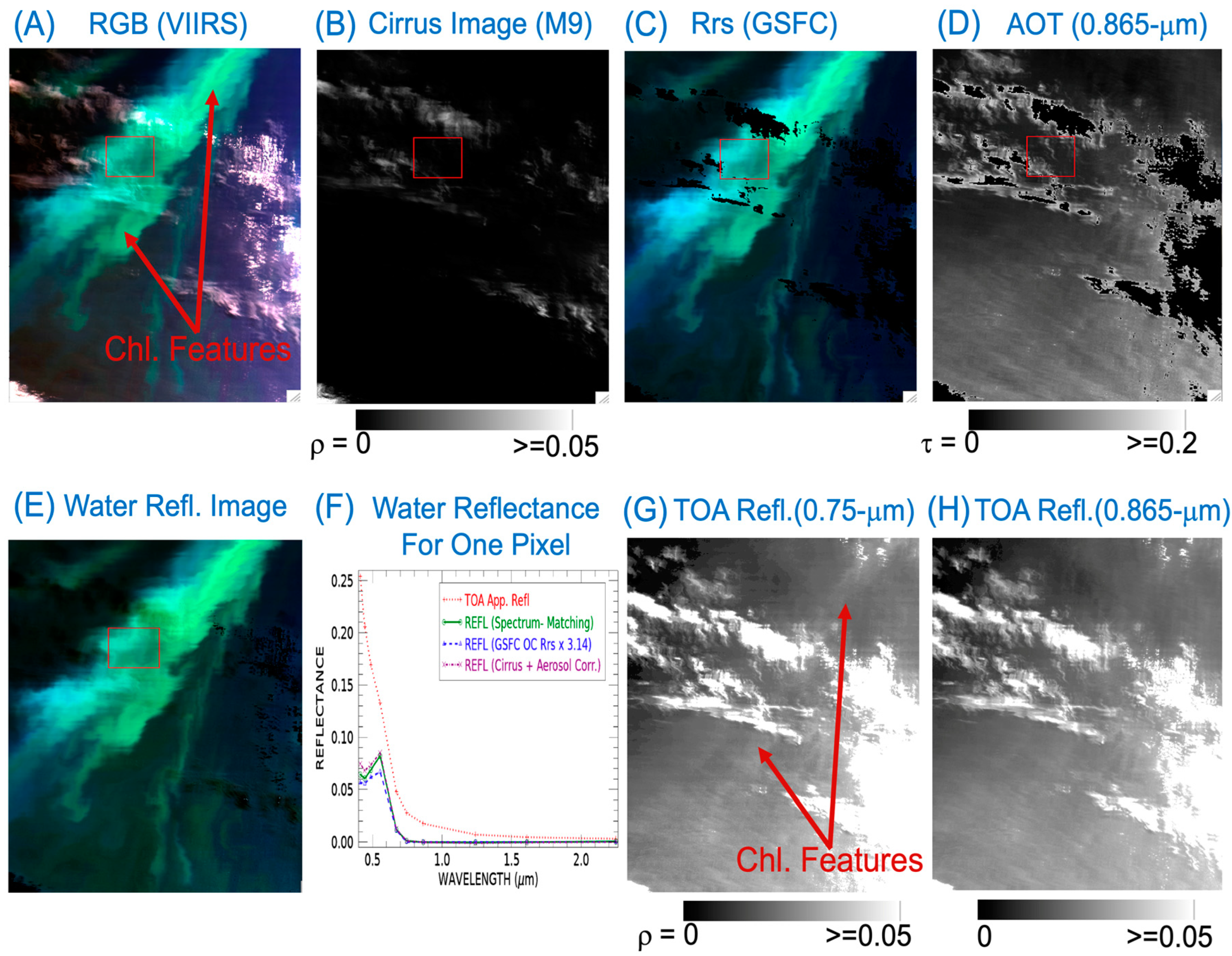
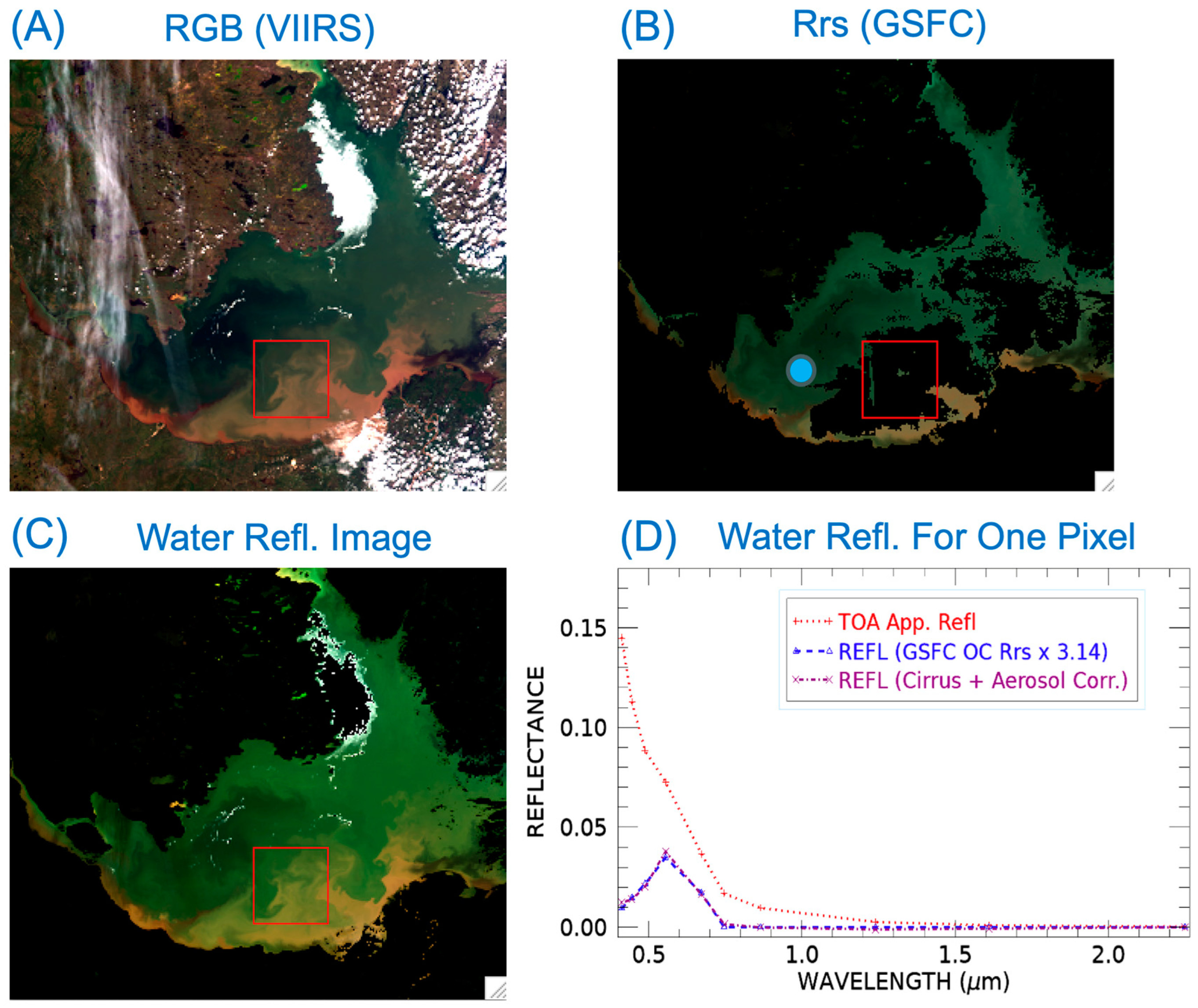
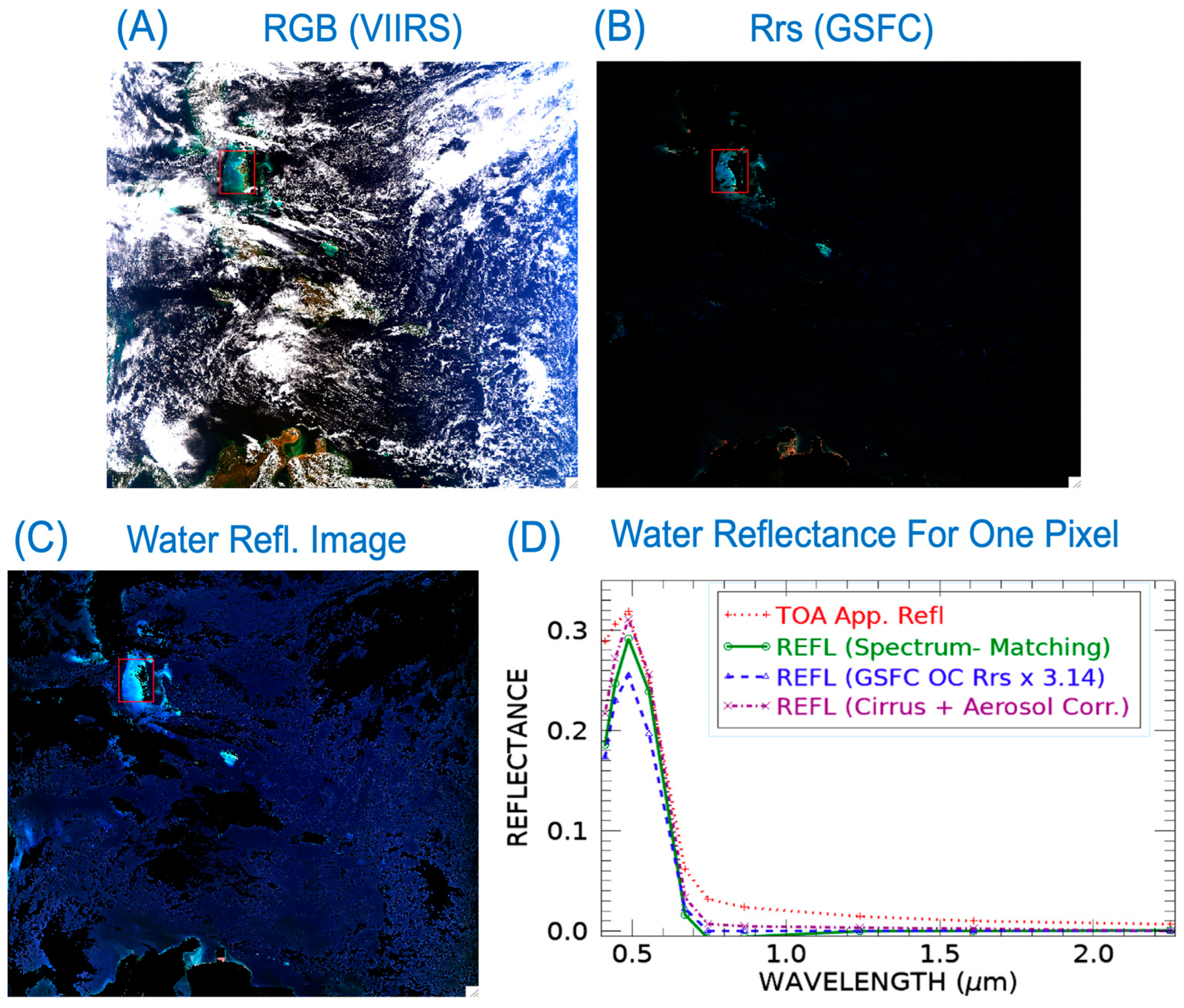
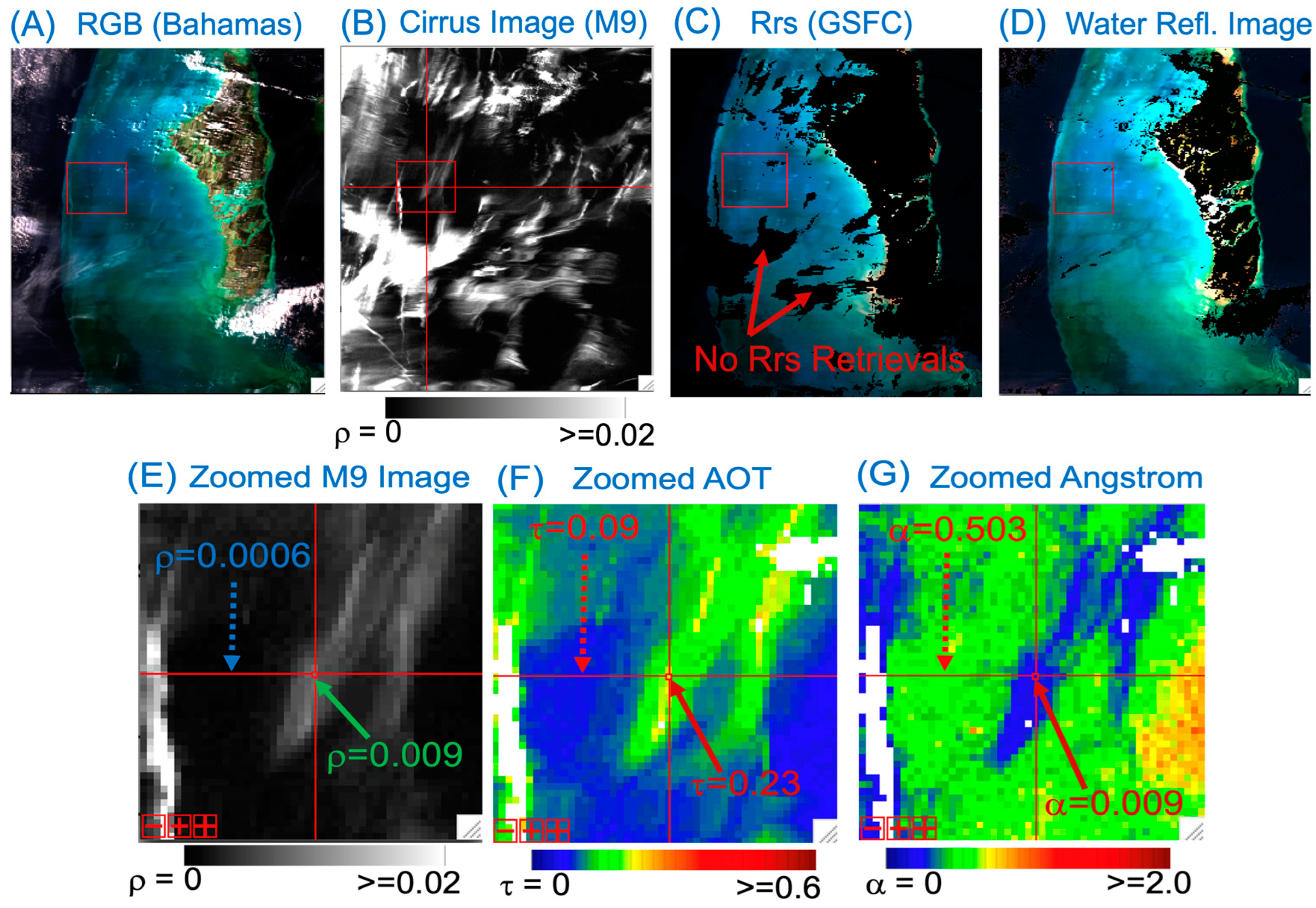

| Bands | Wavelength (μm) | Resolution (m) |
|---|---|---|
| M1 | 0.405–0.425 | 750 |
| M2 | 0.435–0.455 | 750 |
| M3 | 0.480–0.500 | 750 |
| M4 | 0.545–0.565 | 750 |
| M5 | 0.663–0.684 | 750 |
| M6 | 0.736–0.756 | 750 |
| M7 | 0.846–0.885 | 750 |
| M8 | 1.230–1.250 | 750 |
| M9 (Cirrus Band) | 1.368–1.388 | 750 |
| M10 | 1.580–1.640 | 750 |
| M11 | 2.225–2.275 | 750 |
Disclaimer/Publisher’s Note: The statements, opinions and data contained in all publications are solely those of the individual author(s) and contributor(s) and not of MDPI and/or the editor(s). MDPI and/or the editor(s) disclaim responsibility for any injury to people or property resulting from any ideas, methods, instructions or products referred to in the content. |
© 2025 by the authors. Licensee MDPI, Basel, Switzerland. This article is an open access article distributed under the terms and conditions of the Creative Commons Attribution (CC BY) license (https://creativecommons.org/licenses/by/4.0/).
Share and Cite
Gao, B.-C.; Li, R.-R.; Montes, M.J.; McCarthy, S.C. Combining Cirrus and Aerosol Corrections for Improved Reflectance Retrievals over Turbid Waters from Visible Infrared Imaging Radiometer Suite Data. Oceans 2025, 6, 28. https://doi.org/10.3390/oceans6020028
Gao B-C, Li R-R, Montes MJ, McCarthy SC. Combining Cirrus and Aerosol Corrections for Improved Reflectance Retrievals over Turbid Waters from Visible Infrared Imaging Radiometer Suite Data. Oceans. 2025; 6(2):28. https://doi.org/10.3390/oceans6020028
Chicago/Turabian StyleGao, Bo-Cai, Rong-Rong Li, Marcos J. Montes, and Sean C. McCarthy. 2025. "Combining Cirrus and Aerosol Corrections for Improved Reflectance Retrievals over Turbid Waters from Visible Infrared Imaging Radiometer Suite Data" Oceans 6, no. 2: 28. https://doi.org/10.3390/oceans6020028
APA StyleGao, B.-C., Li, R.-R., Montes, M. J., & McCarthy, S. C. (2025). Combining Cirrus and Aerosol Corrections for Improved Reflectance Retrievals over Turbid Waters from Visible Infrared Imaging Radiometer Suite Data. Oceans, 6(2), 28. https://doi.org/10.3390/oceans6020028








